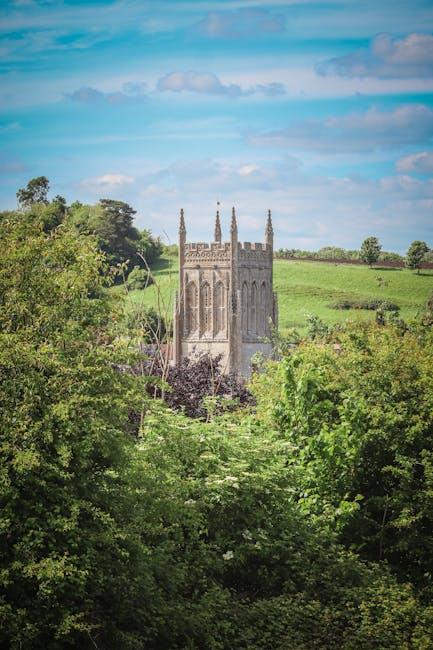In the realm of cinematic artistry, few directors have left as indelible a mark on the genre of gothic fantasy as Tim Burton. With his distinctive visual flair and penchant for the macabre, Burton has redefined the boundaries of gothic cinema, crafting worlds that are as hauntingly beautiful as they are narratively compelling. This article delves into the unique elements that characterize Burton’s dark fantasy realms, examining how his visionary approach has not only captivated audiences but also influenced a generation of filmmakers. Through an analytical lens, we explore the thematic depth, stylistic innovations, and cultural impact of Burton’s oeuvre, asserting his role as a transformative figure in modern cinema.
Visual Aesthetics and Symbolism in Burtons Cinematic Universe
Tim Burton’s films are renowned for their distinct visual aesthetics, where the use of shadow and light creates a haunting yet whimsical atmosphere. His cinematic universe is characterized by a Gothic art style that seamlessly blends the macabre with the fantastical. Burton’s meticulous attention to detail is evident in the intricate set designs and elaborate costumes, which often feature exaggerated shapes and contrasting colors. These elements not only captivate the audience but also serve as a visual metaphor for the duality present in his narratives—juxtaposing beauty and darkness, innocence and corruption.
- Expressionistic Architecture: Angular and distorted buildings that echo the inner turmoil of his characters.
- Color Palette: A strategic use of muted tones interspersed with vibrant hues to highlight emotional depth.
- Iconic Characters: From the elongated figures of Jack Skellington to the stark contrasts of Edward Scissorhands, each character embodies a symbolic essence.
Symbolism in Burton’s work is equally profound, often exploring themes of isolation, identity, and otherness. His characters, like the outsider protagonists, navigate worlds that reflect their internal struggles, using their unique attributes to ultimately redefine their destinies. Burton’s use of visual motifs, such as spirals and stripes, not only reinforces the surreal quality of his films but also serves as a narrative device, guiding the viewer through his labyrinthine stories.

Character Archetypes: From Misfits to Antiheroes
Tim Burton’s universe is a tapestry of enigmatic characters, where the line between misfits and antiheroes is delightfully blurred. These archetypes are not merely outcasts; they are the beating heart of Burton’s storytelling, often challenging societal norms and offering a unique lens through which to view the world. Characters like Edward Scissorhands and Jack Skellington are quintessential examples, embodying a sense of alienation yet yearning for acceptance and belonging.
- Edward Scissorhands: A gentle soul trapped in a monstrous exterior, symbolizing the pain of isolation and the quest for human connection.
- Jack Skellington: The Pumpkin King of Halloween Town, driven by a desire to break free from monotony, representing the eternal struggle between duty and desire.
Burton’s antiheroes are not defined by traditional heroism but by their complexity and moral ambiguity. They often defy conventional expectations, making them both relatable and profoundly intriguing. These characters challenge viewers to embrace their imperfections, celebrating the beauty found in the unconventional and the misunderstood.

The Evolution of Narrative Themes in Burtons Filmography
Tim Burton’s cinematic journey is a tapestry of evolving narrative themes that have consistently redefined the contours of gothic cinema. From the whimsical yet eerie landscapes of Edward Scissorhands to the hauntingly beautiful realms of Sleepy Hollow, Burton’s films delve into the complexities of outsider identity and societal norms. His protagonists often grapple with isolation, a recurring motif that reflects the director’s fascination with the misunderstood. This exploration is not merely aesthetic; it underscores a deeper narrative of finding belonging in a world that shuns the different.
Over time, Burton has expanded his thematic repertoire to include elements such as mortality and existential reflection, particularly evident in works like Corpse Bride and Frankenweenie. These films juxtapose life and death, offering poignant commentary on love, loss, and the afterlife. Key themes that frequently appear in Burton’s storytelling include:
- Isolation and Otherness: Characters who are outcasts, reflecting Burton’s own sentiments.
- Dark Humor: A unique blend of comedy within macabre settings.
- Whimsical Gothic Aesthetics: A signature style that merges fantasy with horror.
Through these evolving themes, Burton crafts a unique narrative voice, making his films both timeless and universally resonant.

Impact and Legacy: Burtons Influence on Modern Gothic Cinema
Tim Burton’s unique vision has indelibly marked the landscape of modern gothic cinema, intertwining whimsy with darkness to create a style that is both iconic and enduring. His influence is evident in the works of contemporary filmmakers who embrace the blend of fantasy and the macabre. Burton’s films, such as Edward Scissorhands and Sleepy Hollow, have become benchmarks for how gothic elements can be interwoven with heartfelt storytelling, setting a precedent for the genre.
Burton’s legacy is not just in his storytelling but also in the aesthetic and thematic choices that have become staples in the genre. Key elements include:
- Visual Style: A distinctive blend of quirky and eerie, characterized by stark contrasts and surreal landscapes.
- Character Archetypes: Misunderstood outsiders and fantastical beings that resonate with audiences.
- Soundtracks: Collaborations with composers like Danny Elfman that enhance the gothic atmosphere.
These components have inspired a new wave of filmmakers who seek to capture the same magic that Burton has perfected. His impact continues to echo through cinema, proving that the gothic can be both haunting and beautiful.

